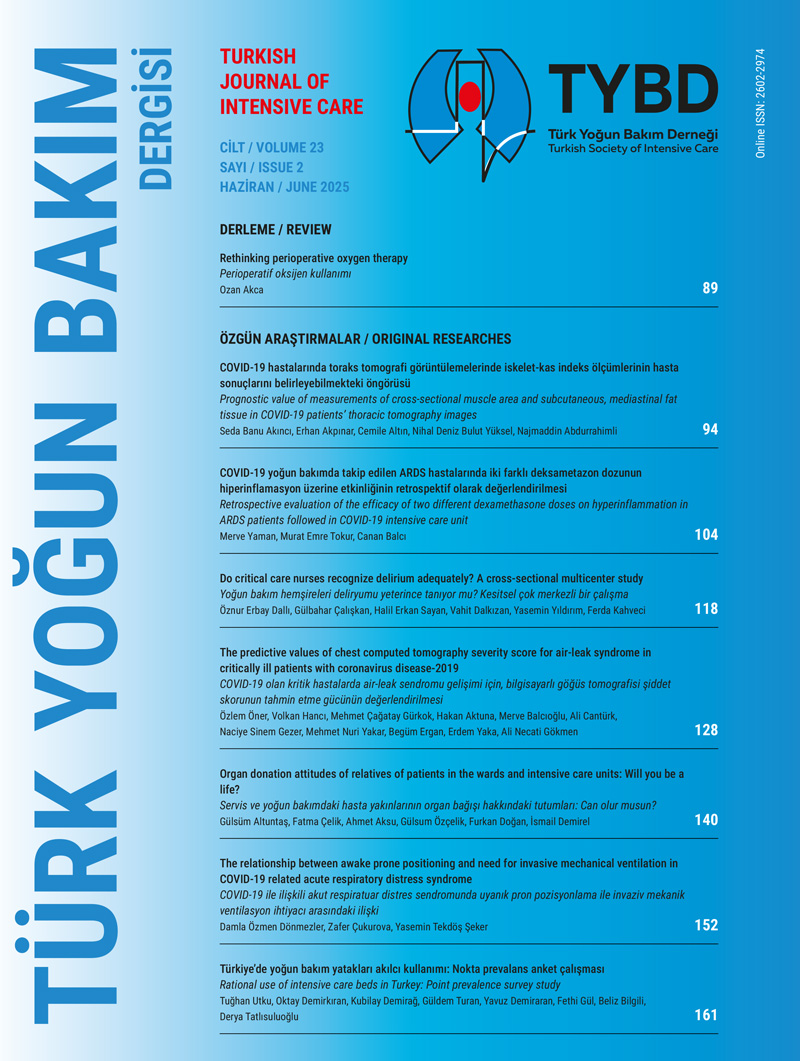Abstract
Introduction: Sarcopenia is common in patients with COVID-19 who are admitted to the ICU. Cross-sectional muscle area measurement calculated from thoracic tomography imaging is a method to evaluate presence of sarcopenia. We aimed to investigate the prognostic value of the muscle and fat tissue volume measurements which are calculated from the chest CT images taken at ICU admission in COVID-19 pneumonia patients, in terms of duration of MV, ICU stay and the rate of mortality.
Methods: After ethical committee approval, adult patients who were admitted to the ICU between August 2020 and February 2021, with positive COVID PCR and respiratory distress were included into the study. Patients with inadequate thorax tomography imaging were excluded. The laboratory parameters, admission APACHEII, SOFA, NUTRIC scores, durations of MV, ICU and hospital stay, rates of mortality at 28 and 90 days were recorded from the hospital data system. Chi-Square Tests, Mann-Whitney U tests, Spearman correlations, multivariate binary logistic regression tests were used for statistical analyses.
Results: A total of 139 patients were included into the analysis. The median duration of mechanical ventilation was 7 days, ICU stay was 17 days, and the 90-day mortality rate was 43%. There were no statistically significant correlations between the measurement of the muscle/fat tissue volume and the NUTRIC score, the durations of the MV, ICU or hospital stay. We found significant correlations between NUTRIC score and the duration of MV (p <0.01, r = 0.364), ICU stay (p = 0.011, r =0.216), the prealbumin value on the 14th day (p<0.01, r=0.496).The NUTRIC score (B=0.558, p.026) and SOFA score (B=0.760, p.001) at admission day were independent predictors of mortality.
Discussion and Conclusion: The measurements of muscle and fat tissue volume from chest CT images don’t have prognostic value for predicting duration of MV, ICU stay and mortality whereas NUTRIC score is a predictor for mortality in critically ill COVID-19 patients.
Keywords: COVID-19, sarcopenia, muscle/fat volume
References
- Welch C, Greig C, Masud T, Wilson D, Jackson TA. COVID-19 and Acute Sarcopenia. Aging Dis. 2020;11:1345-51. https://doi.org/10.14336/AD.2020.1014
- Cruz-Jentoft AJ, Bahat G, Bauer J, et al. Sarcopenia: revised European consensus on definition and diagnosis. Age Ageing. 2019;48:16-31. https://doi.org/10.1093/ageing/afy169
- Okazaki T, Ebihara S, Mori T, Izumi S, Ebihara T. Association between sarcopenia and pneumonia in older people. Geriatr Gerontol Int. 2020;20:7-13. https://doi.org/10.1111/ggi.13839
- T.C. Sağlık Bakanlığı, Halk Sağlığı Genel Müdürlüğü. COVID-19 (SARS-CoV-2 Enfeksiyonu) Ağır Pnömoni, Ards, Sepsis ve Septik Şok Yönetimi. Ankara: T.C. Sağlık Bakanlığı; 2021. Available at: https://covid19.saglik.gov.tr/TR-66340/agir-pnomoni-ards-sepsis-ve-septik-sok-yonetimi.html
- Qin ES, Hough CL, Andrews J, Bunnell AE. Intensive care unit-acquired weakness and the COVID-19 pandemic: A clinical review. PM R. 2022;14:227-38. https://doi.org/10.1002/pmrj.12757
- Wunsch H. Mechanical Ventilation in COVID-19: Interpreting the Current Epidemiology. Am J Respir Crit Care Med. 2020;202:1-4. https://doi.org/10.1164/rccm.202004-1385ED
- King CS, Sahjwani D, Brown AW, et al. Outcomes of mechanically ventilated patients with COVID-19 associated respiratory failure. PLoS One. 2020;15:e0242651. https://doi.org/10.1371/journal.pone.0242651
- Zhang XM, Chen D, Xie XH, Zhang JE, Zeng Y, Cheng AS. Sarcopenia as a predictor of mortality among the critically ill in an intensive care unit: a systematic review and meta-analysis. BMC Geriatr. 2021;21:339. https://doi.org/10.1186/s12877-021-02276-w
- Frithiof R, Rostami E, Kumlien E, et al. Critical illness polyneuropathy, myopathy and neuronal biomarkers in COVID-19 patients: A prospective study. Clin Neurophysiol. 2021;132:1733-40. https://doi.org/10.1016/j.clinph.2021.03.016
- Van Aerde N, Van den Berghe G, Wilmer A, Gosselink R, Hermans G, COVID-19 Consortium. Intensive care unit acquired muscle weakness in COVID-19 patients. Intensive Care Med. 2020;46:2083-5. https://doi.org/10.1007/s00134-020-06244-7
- Moon SW, Choi JS, Lee SH, et al. Thoracic skeletal muscle quantification: low muscle mass is related with worse prognosis in idiopathic pulmonary fibrosis patients. Respir Res. 2019;20:35. https://doi.org/10.1186/s12931-019-1001-6
- Nemec U, Heidinger B, Sokas C, Chu L, Eisenberg RL. Diagnosing Sarcopenia on Thoracic Computed Tomography: Quantitative Assessment of Skeletal Muscle Mass in Patients Undergoing Transcatheter Aortic Valve Replacement. Acad Radiol. 2017;24:1154-61. https://doi.org/10.1016/j.acra.2017.02.008
- Boutin RD, Bamrungchart S, Bateni CP, et al. CT of Patients With Hip Fracture: Muscle Size and Attenuation Help Predict Mortality. AJR Am J Roentgenol. 2017;208:W208-15. https://doi.org/10.2214/AJR.16.17226
- Hajjar LA, Costa IBSDS, Rizk SI, et al. Intensive care management of patients with COVID-19: a practical approach. Ann Intensive Care. 2021;11:36. https://doi.org/10.1186/s13613-021-00820-w
- Antonarelli M, Fogante M. Chest CT-Derived Muscle Analysis in COVID-19 Patients. Tomography. 2022;8:414-22. https://doi.org/10.3390/tomography8010034
- Giraudo C, Librizzi G, Fichera G, et al. Reduced muscle mass as predictor of intensive care unit hospitalization in COVID-19 patients. PLoS One. 2021;16:e0253433. https://doi.org/10.1371/journal.pone.0253433
- Menozzi R, Valoriani F, Prampolini F, et al. Impact of sarcopenia in SARS-CoV-2 patients during two different epidemic waves. Clin Nutr ESPEN. 2022;47:252-9. https://doi.org/10.1016/j.clnesp.2021.12.001
- Izcovich A, Ragusa MA, Tortosa F, et al. Prognostic factors for severity and mortality in patients infected with COVID-19: A systematic review. PLoS One. 2020;15:e0241955. https://doi.org/10.1371/journal.pone.0241955
- Barrett B, Pamphile S, Yang F, et al. Inflammatory markers are poorly predictive of clinical outcomes among hospitalized patients with COVID-19. Am J Emerg Med. 2021;46:595-8. https://doi.org/10.1016/j.ajem.2020.11.038
- de Bruin S, Bos LD, van Roon MA, et al. Clinical features and prognostic factors in Covid-19: A prospective cohort study. EBioMedicine. 2021;67:103378. https://doi.org/10.1016/j.ebiom.2021.103378
- Leoni MLG, Moschini E, Beretta M, Zanello M, Nolli M. The modified NUTRIC score (mNUTRIC) is associated with increased 28-day mortality in critically ill COVID-19 patients: Internal validation of a prediction model. Clin Nutr ESPEN. 2022;48:202-9. https://doi.org/10.1016/j.clnesp.2022.02.014
- Kumar N, Kumar A, Kumar A, Pattanayak A, Singh K, Singh PK. NUTRIC score as a predictor of outcome in COVID-19 ARDS patients: A retrospective observational study. Indian J Anaesth. 2021;65:669-75. https://doi.org/10.4103/ija.ija_474_21
- Nishimura JM, Ansari AZ, D'Souza DM, Moffatt-Bruce SD, Merritt RE, Kneuertz PJ. Computed Tomography-Assessed Skeletal Muscle Mass as a Predictor of Outcomes in Lung Cancer Surgery. Ann Thorac Surg. 2019;108:1555-64. https://doi.org/10.1016/j.athoracsur.2019.04.090
- Wakefield CJ, Lund N, Coughlin J, et al. The association between thoracic sarcopenia and survival is gender specific in early-stage lung cancer. J Thorac Dis. 2022;14:4256-65. https://doi.org/10.21037/jtd-22-273
Copyright and license
Copyright © 2025 The author(s). This is an open access article distributed under the Creative Commons Attribution License (CC BY), which permits unrestricted use, distribution, and reproduction in any medium or format, provided the original work is properly cited.






















